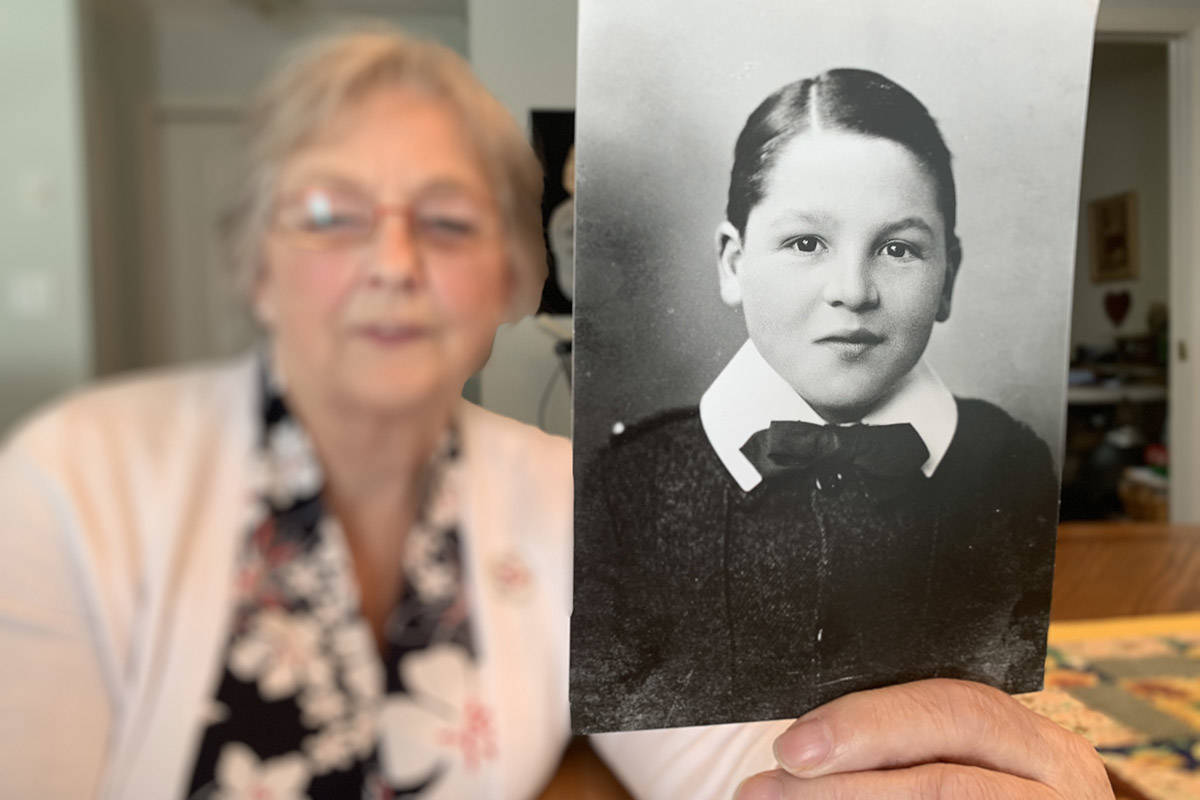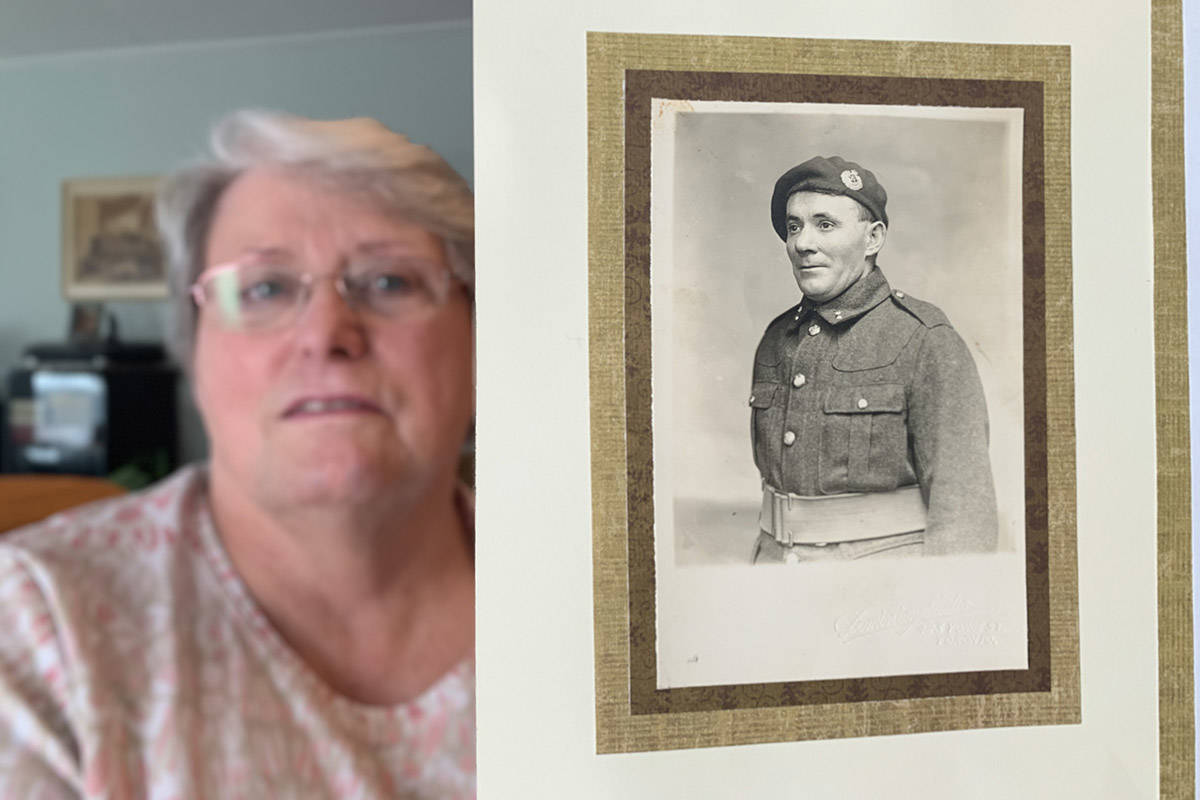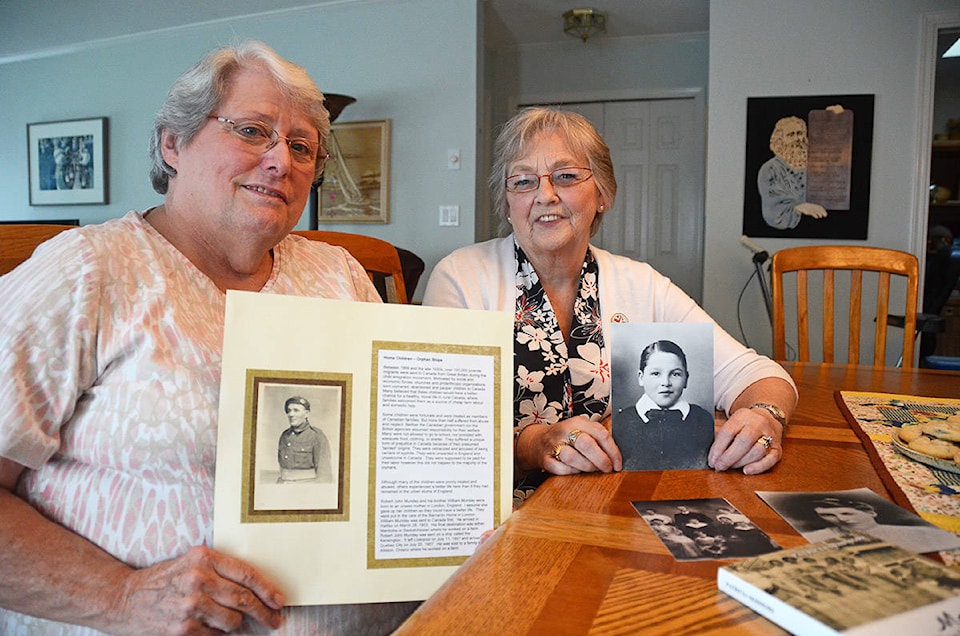When Carol Bateman’s father was 12 years old in 1915, he boarded a passenger liner with many other children, the SS Missanabie in Liverpool, England, and sailed to New Brunswick.
This was a life-changing event for young Sheriff Atcheson Thompson, but it was not a move of his own choosing.
| Carol Bateman of Chilliwack with a photo of her father, Sheriff Thompson who was one of the 100,000 British Home Children shipped from England to Canada between 1869 and 1948. (Paul Henderson/ The Progress) |
Upon arrival, Sheriff was sent to The Fegan Home in Toronto, a so-called “distributing” house. There the children would wait. Farmers would come to the city, choose a boy or a girl, pay $2 or $3, and take them home.
What in hindsight looks like purchasing children like chattel, was apparently done with the best intentions at the time by both the British and Canadian governments.
What awaited these kids, however, the British Home Children as they are known, was a diverse range of futures from that of abused and indentured servants, all the way up to loved adoptees in new-found homes. And everything in between.
“My grandfather was not well fed,” Daily said during a recent visit with she and Bateman, descendants of British Home Children. “He subsisted mostly on apples that he found, vegetables he could find in the garden. He was put in the barn and it wasn’t heated so he slept in there. He was beaten at times. It was not a happy place for him.”
Bateman’s father, however, was treated well by his “adopted” family, the Kirbys from Port Perry, Ontario. When Sheriff got scarlet fever and the Kirbys brought him back to the distributing home, a replacement boy was offered.
“It was like merchandise, right?” Bateman said, “But Mr. Kirby said, ‘I like this boy. I’ll wait for him.’”
Who were the British Home Children?
Bateman’s father and Daily’s grandfather are but two examples of the tens of thousands of children of all ages shipped to Canada from 1869 up until 1948 by well-known organizations such as Barnardo’s, The Salvation Army, and others.
Many say the policy was well-intentioned, aiming to help with labour shortages in Canada while offering up new lives to children who may have been otherwise impoverished or alone. In reality, the program was designed to rid England of an over-abundance of children living on the streets or in orphanages or in sub-optimal family situations, all while providing Canadian farmers with slave labour.
It’s estimated four to five million Canadians today are descendants of British Home Children. In 2011, the Canadian government designated September 28 as British Home Children day. This year marks the 150th year since the first BHC arrived in Canada, a legacy of trauma and child abuse that is not well-known by the vast majority of Canadians.
And while Canada has formally apologized for the horrific residential school legacy inflicted on Indigenous people, and as knowledge of that attempted cultural genocide becomes more understood, the 100,000 British Home Children (BHC) brought to this country to become indentured farm workers and domestic slaves are largely forgotten.
| Shirley Daily of Chilliwack with a photo of her grandfather, Robert Munday who was one of the 100,000 British Home Children shipped from England to Canada between 1869 and 1948. (Paul Henderson/ The Progress) |
“It should be taught in schools,” Bateman said. “That is my focus from the beginning. That is how you honour them and how you bring them out of this sadness.”
Part of why it was hidden was because the children were told not to talk about it, not that many would have anyway because of the shame.
Daily found out her grandfather was a BHC later in life when she looked into her ancestry. He was listed as an illegitimate child, but she kept digging and found out he was on a “party” of 230 kids sent in 1907. His older brother was sent in 1902, apparently to a good, loving home, his half sister in 1903 to who-knows-where.
In hindsight, she realized that the fact he never talked about his childhood was not unusual.
“He wouldn’t talk about it,” she said. “You find this so often. They were afraid to talk about it as if they were ashamed of what had happened. Children were told to never to tell anybody about what was happening.”
The shame was palpable, and it led to a spate of suicides in the 1920s. Many children were violently abused, others mentally tortured, all of it a shameful period in Canada’s history.
Daily’s grandfather ran away at age 16, presumably to Toronto where he met and married her grandmother. He enlisted and went overseas in the First World War. He was wounded, came back, eventually had a life that included having nine children, and involvement in the Second World War.
Canada has never apologized despite the fact that Britain and Australia have. Current Alberta Premier Jason Kenney, back in 2009 as Immigration Minister in the federal Conservative government, said the issue was not on “the radar screen.”
He mistakenly suggested the issue was a matter of “British policy” and that no one in Canada was asking for an apology.
“The reality is that here in Canada we are taking measures to recognize that sad period, but there is, I think, limited public interest in official government apologies for everything that’s ever been unfortunate or (a) tragic event in our history.
“And we’ve laid out some pretty clear criteria for where such apologies would be appropriate and on a limited basis.” That quote is from a Star story from Nov. 16, 2009.
At the time, a spokesperson for Home Children Canada said he was “very disappointed” in Kenney’s response.
Bateman expressed her displeasure with Kenney’s ambivalence to the BHC cause as well. It’s worth noting at this point that Bateman, whose father was a BHC, is the maternal grandmother of Chilliwack-Hope MP Mark Strahl. Strahl rose in Parliament in 2017 to support a motion to recognize the BHC, quoting extensively from his grandmother’s words.
“She is fiercely proud of her family, and fiercely proud of her father and all that he accomplished,” Strahl said. “He came from nothing, and was treated as worse than nothing when he arrived, just as an indentured farm servant. Now, 60 family members are his descendants. What a legacy.”
Bateman tells one of her most compelling stories of her father and her keepers, the Kirbys, who located his brother, similarly indentured to a family not far away in rural Ontario. The boys were made to work hard every day, but Sunday afternoons they had some free time.
Bateman’s father Sheriff lived in Port Perry, her Uncle Dick in Janetville 30 kilometres away. On those Sunday afternoons, each boy would walk 15 kilometres and the two would meet in the middle, interact briefly until they had to turn around and walk back home for dinnertime.
“They would meet for the few minutes they had and then walk back to their farm,” she said. “Uncle Dick had tears in his eyes and often cried when he told that story. His family was childless and wanted to adopt him, but blood is thicker than water.”
Bateman’s father died in 1960 at the age of 57.
Daily’s grandfather never talked about his childhood as a BHC. But he was reunited with his brother in 1975, 72 years after they were first separated.
In 2011, Bateman flew to Toronto for a one-time open house at The Fegan Home for descendants of BHC. She toured the building, which was emotional for all involved. She went outside and her cousin said, “Come here, you have to see this.”
There, scratched on a brick on a house at 295 George St. was her father’s name, “Sheriff.”
“They took a piece of rock or glass and scratched their names,” she said. “Surprisingly enough I did not cry. I just stood there like I was awestruck. He stood here. Was he wanting people to know he was alive?
“I said, ‘If this building goes down, you better know that brick is mine.’”
To learn more about the BHC, including a link to researching descendants of the BHC, visit www.britishhomechildren.com.
@PeeJayAitch
paul.henderson@theprogress.com
Like us on Facebook and follow us on Twitter.


